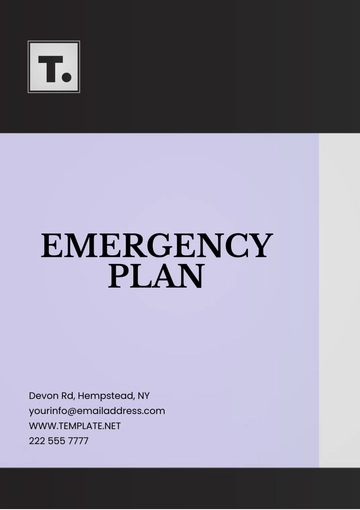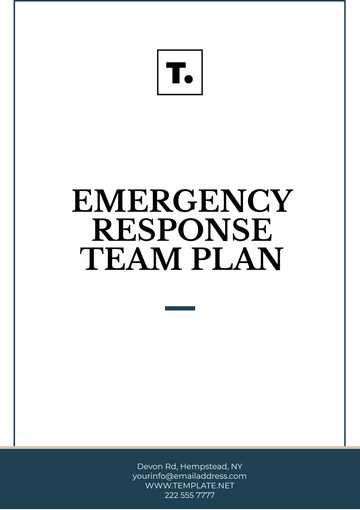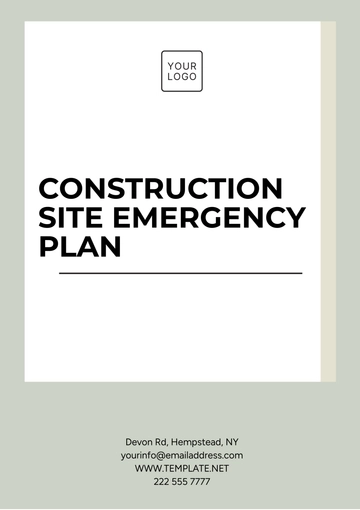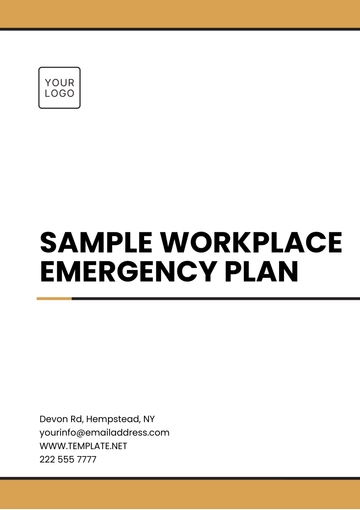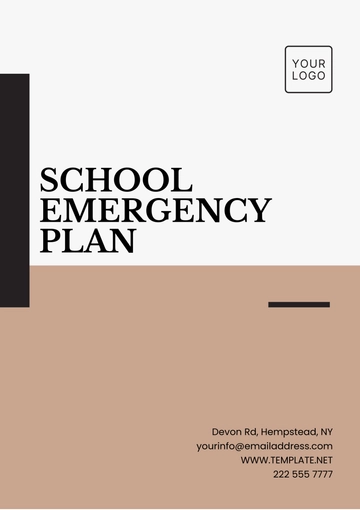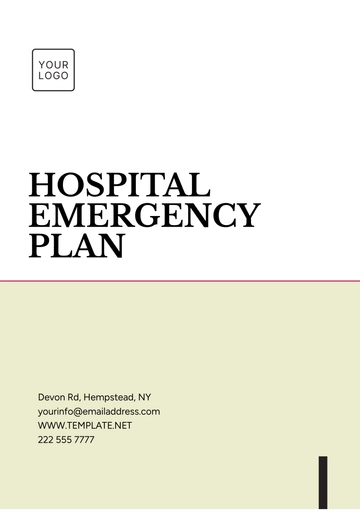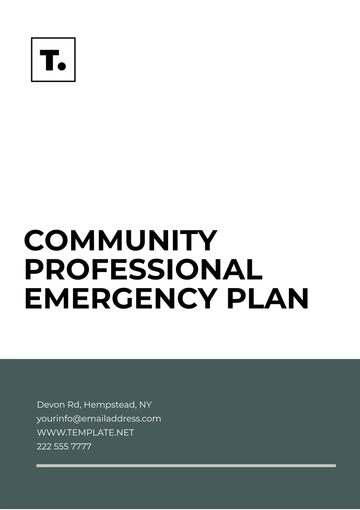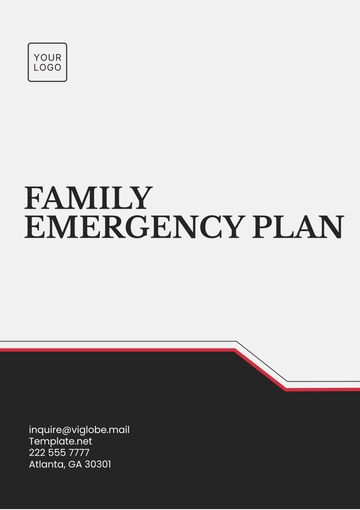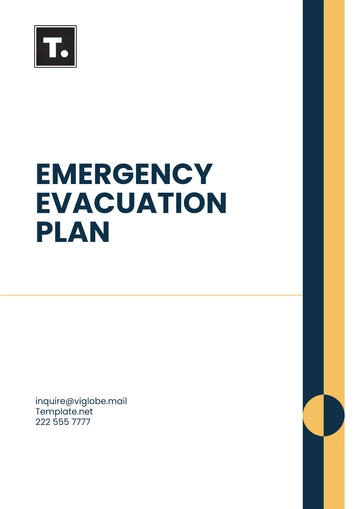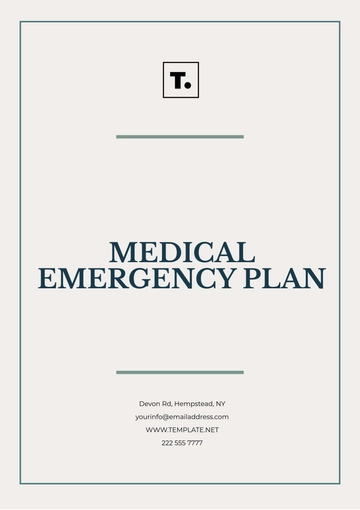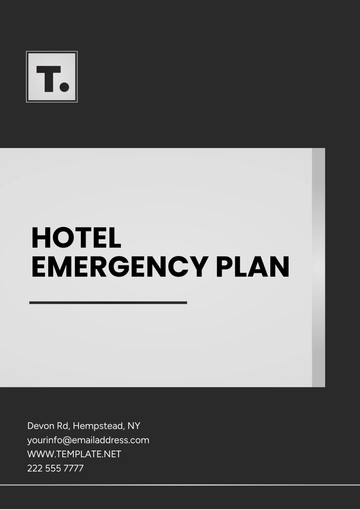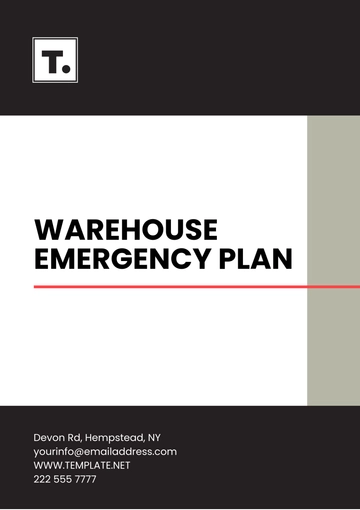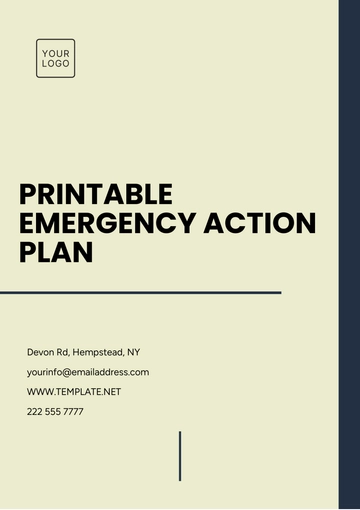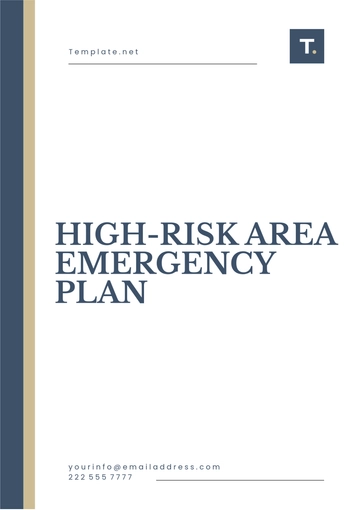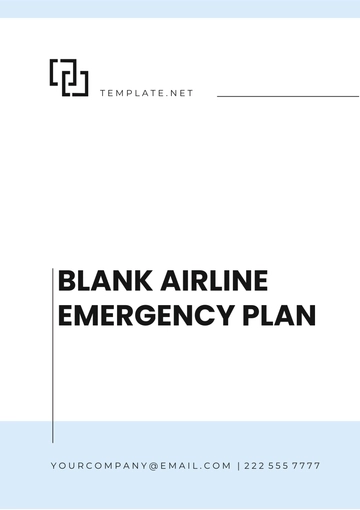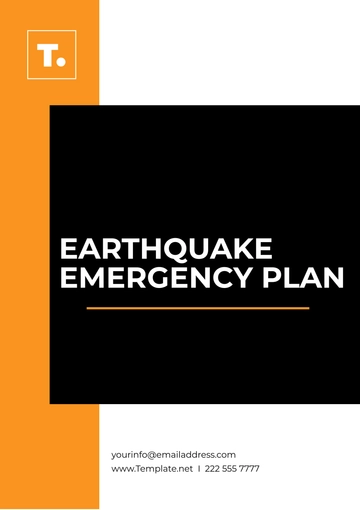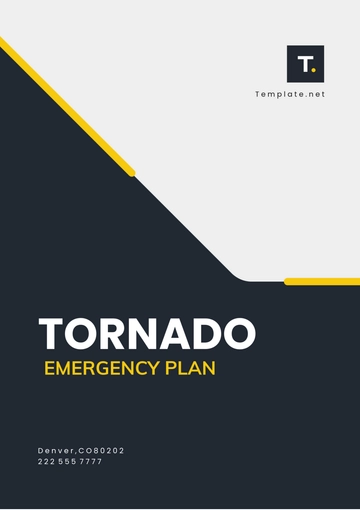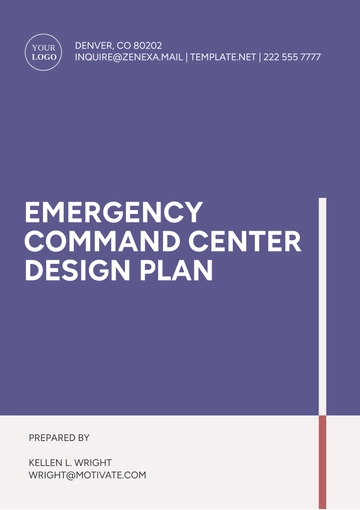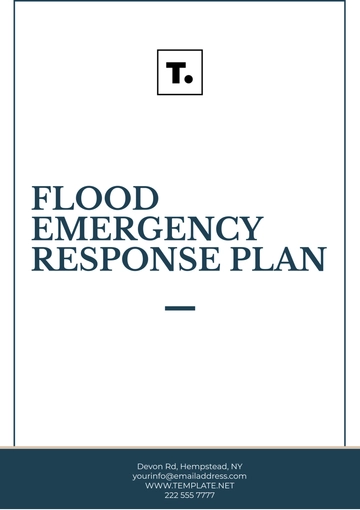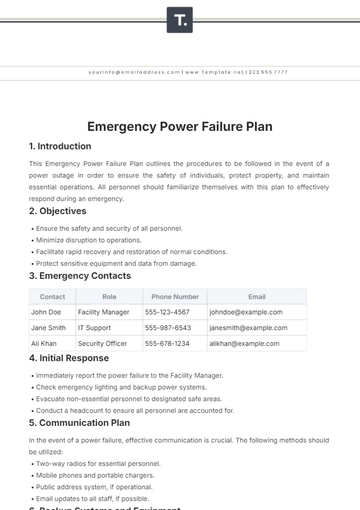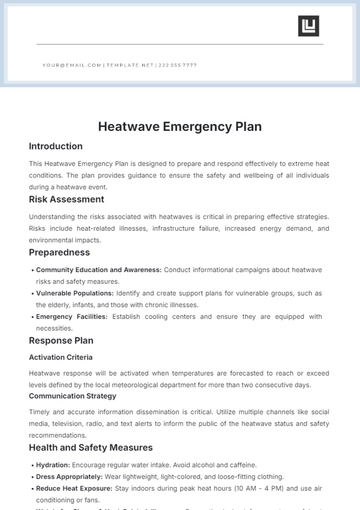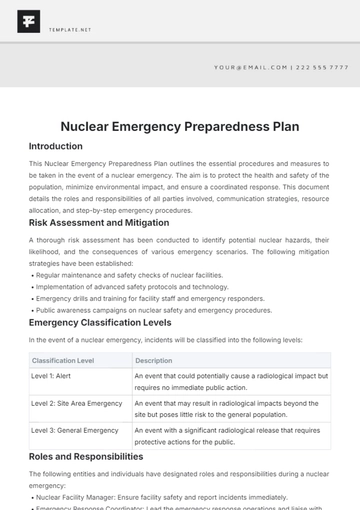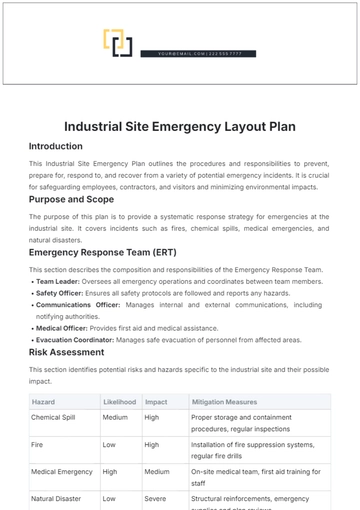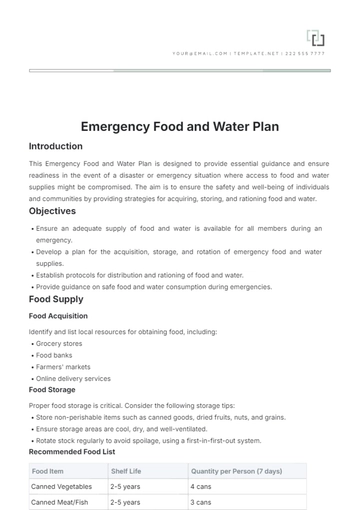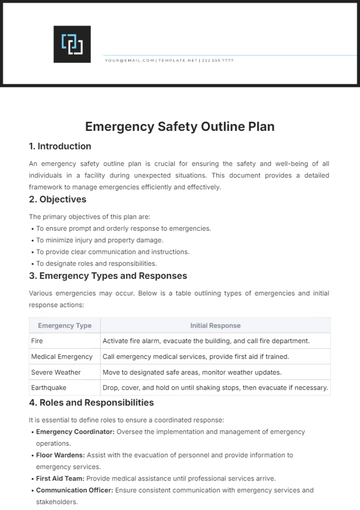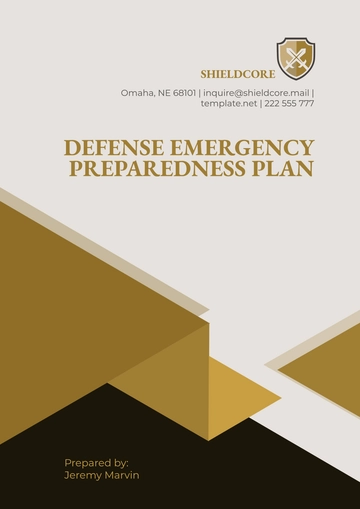Free Family Emergency Plan
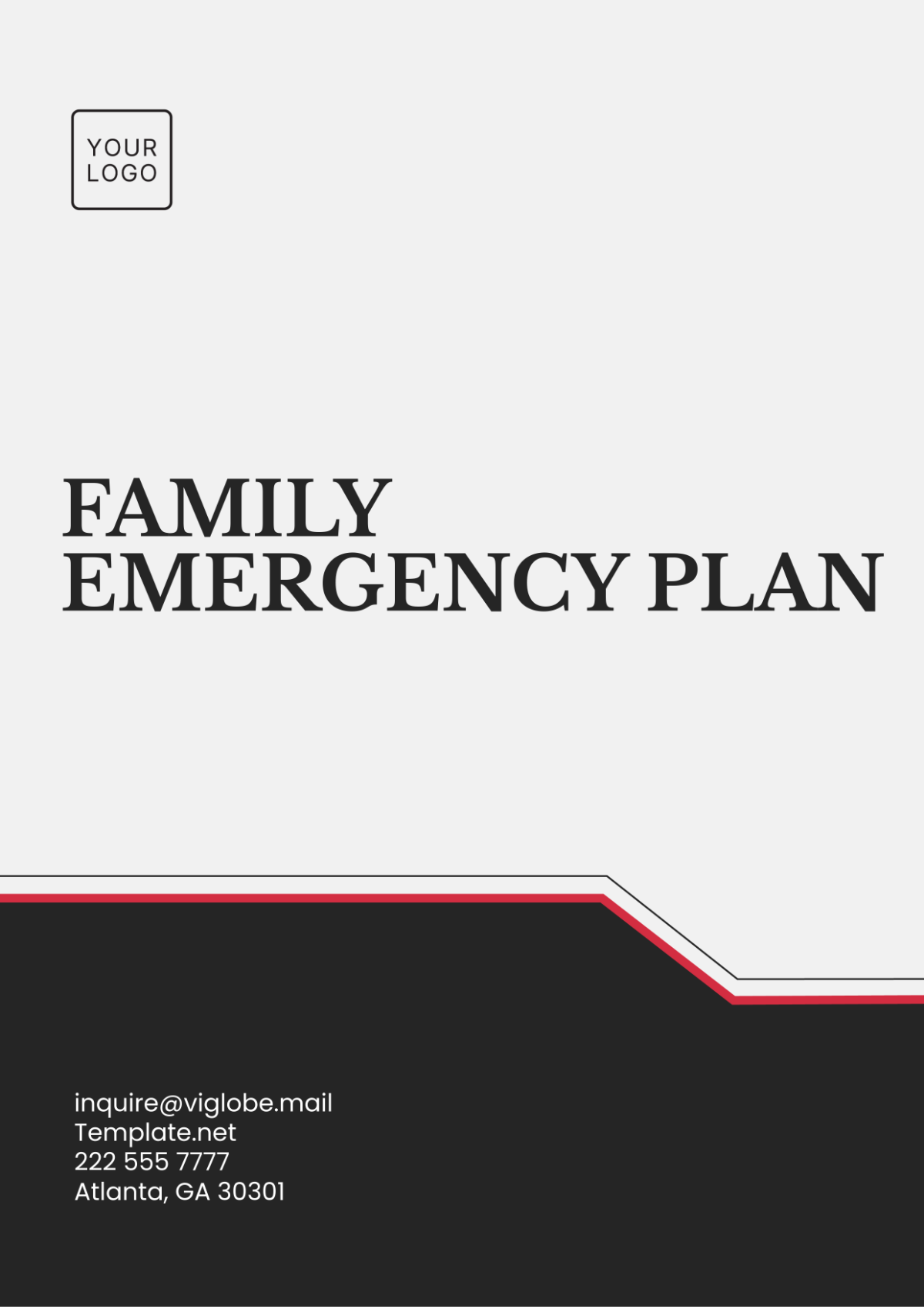
Introduction
Emergencies can happen unexpectedly, so it's crucial for every family to have a comprehensive emergency plan in place. This document outlines steps and supplies necessary to ensure the safety and preparedness of your family during unexpected events.
Emergency Contacts
It's important to have a list of essential emergency contacts readily available for all family members. Ensure that everyone knows where this list is located.
Contact | Name | Phone Number | Address |
|---|---|---|---|
Local Emergency Number | 911 | 911 | N/A |
Police Department | Main Town Police | (123) 456-7890 | 123 Main St, Anytown, USA |
Fire Department | Main Town Fire Dept | (123) 456-7891 | 456 Elm St, Anytown, USA |
Family Doctor | Dr. Jane Smith | (123) 456-7892 | 789 Maple St, Anytown, USA |
Out-of-Town Contact | John Doe | (987) 654-3210 | 987 Spruce Lane, Othertown, USA |
Meeting Locations
Designate two specific meeting locations where family members can reunite if separated during an emergency.
1. Near Home: ABC Park at the corner of 1st Avenue and Main Street
2. Outside Local Area: DEF Community Center, 321 Oak Lane, Othertown, USA
Communication Plan
During an emergency, effective communication is essential. Here are the steps to ensure all family members can communicate effectively:
Ensure all family members have each other's phone numbers programmed in their phones.
Agree on a method of communication if phone services are down, such as text, email, or social media.
Check in with the designated out-of-town contact to relay information to other family members.
Disaster Supply Kit
Prepare a disaster supply kit that contains essential items for survival in case of an evacuation or extended stay at home:
Water: One gallon per person per day for at least three days.
Food: At least a three-day supply of non-perishable items.
Battery-powered or hand-crank radio and a NOAA Weather Radio with tone alert.
Flashlight and extra batteries.
First aid kit.
Whistle to signal for help.
Dust mask to help filter contaminated air, plastic sheeting, and duct tape to shelter in place.
Moist towelettes, garbage bags, and plastic ties for personal sanitation.
Wrench or pliers to turn off utilities.
Manual can opener for food.
Local maps.
Evacuation Plan
Develop a clear evacuation plan in case you need to leave your home quickly:
Choose evacuation routes in advance and make sure each family member knows them.
Keep the car's gas tank at least half full at all times.
Identify places you could go in an emergency, such as a hotel, friend's house, or shelter.
Consider how you will transport your pets if necessary.
Important Documents
Ensure that all critical documents are safe and accessible during an emergency:
Store copies of important documents in an easy-to-carry, waterproof container.
Include identification cards, insurance policies, medical records, and bank information.
Review and Practice
No plan is effective unless it is practiced regularly. Schedule regular family meetings to review and practice the emergency plan:
Conduct drills every six months to ensure everyone knows what to do.
Update the plan as necessary based on family changes, new information, or seasonal hazards.
- 100% Customizable, free editor
- Access 1 Million+ Templates, photo’s & graphics
- Download or share as a template
- Click and replace photos, graphics, text, backgrounds
- Resize, crop, AI write & more
- Access advanced editor
Stay prepared for unexpected situations with the Family Emergency Plan Template offered by Template.net. This customizable, downloadable, and printable template helps you create a comprehensive emergency plan tailored to your family’s needs. Easily editable in our AI Editor Tool, you can adjust the details to ensure everyone stays safe and informed during emergencies. Get organized and ready today!
You may also like
- Finance Plan
- Construction Plan
- Sales Plan
- Development Plan
- Career Plan
- Budget Plan
- HR Plan
- Education Plan
- Transition Plan
- Work Plan
- Training Plan
- Communication Plan
- Operation Plan
- Health And Safety Plan
- Strategy Plan
- Professional Development Plan
- Advertising Plan
- Risk Management Plan
- Restaurant Plan
- School Plan
- Nursing Home Patient Care Plan
- Nursing Care Plan
- Plan Event
- Startup Plan
- Social Media Plan
- Staffing Plan
- Annual Plan
- Content Plan
- Payment Plan
- Implementation Plan
- Hotel Plan
- Workout Plan
- Accounting Plan
- Campaign Plan
- Essay Plan
- 30 60 90 Day Plan
- Research Plan
- Recruitment Plan
- 90 Day Plan
- Quarterly Plan
- Emergency Plan
- 5 Year Plan
- Gym Plan
- Personal Plan
- IT and Software Plan
- Treatment Plan
- Real Estate Plan
- Law Firm Plan
- Healthcare Plan
- Improvement Plan
- Media Plan
- 5 Year Business Plan
- Learning Plan
- Marketing Campaign Plan
- Travel Agency Plan
- Cleaning Services Plan
- Interior Design Plan
- Performance Plan
- PR Plan
- Birth Plan
- Life Plan
- SEO Plan
- Disaster Recovery Plan
- Continuity Plan
- Launch Plan
- Legal Plan
- Behavior Plan
- Performance Improvement Plan
- Salon Plan
- Security Plan
- Security Management Plan
- Employee Development Plan
- Quality Plan
- Service Improvement Plan
- Growth Plan
- Incident Response Plan
- Basketball Plan
- Emergency Action Plan
- Product Launch Plan
- Spa Plan
- Employee Training Plan
- Data Analysis Plan
- Employee Action Plan
- Territory Plan
- Audit Plan
- Classroom Plan
- Activity Plan
- Parenting Plan
- Care Plan
- Project Execution Plan
- Exercise Plan
- Internship Plan
- Software Development Plan
- Continuous Improvement Plan
- Leave Plan
- 90 Day Sales Plan
- Advertising Agency Plan
- Employee Transition Plan
- Smart Action Plan
- Workplace Safety Plan
- Behavior Change Plan
- Contingency Plan
- Continuity of Operations Plan
- Health Plan
- Quality Control Plan
- Self Plan
- Sports Development Plan
- Change Management Plan
- Ecommerce Plan
- Personal Financial Plan
- Process Improvement Plan
- 30-60-90 Day Sales Plan
- Crisis Management Plan
- Engagement Plan
- Execution Plan
- Pandemic Plan
- Quality Assurance Plan
- Service Continuity Plan
- Agile Project Plan
- Fundraising Plan
- Job Transition Plan
- Asset Maintenance Plan
- Maintenance Plan
- Software Test Plan
- Staff Training and Development Plan
- 3 Year Plan
- Brand Activation Plan
- Release Plan
- Resource Plan
- Risk Mitigation Plan
- Teacher Plan
- 30 60 90 Day Plan for New Manager
- Food Safety Plan
- Food Truck Plan
- Hiring Plan
- Quality Management Plan
- Wellness Plan
- Behavior Intervention Plan
- Bonus Plan
- Investment Plan
- Maternity Leave Plan
- Pandemic Response Plan
- Succession Planning
- Coaching Plan
- Configuration Management Plan
- Remote Work Plan
- Self Care Plan
- Teaching Plan
- 100-Day Plan
- HACCP Plan
- Student Plan
- Sustainability Plan
- 30 60 90 Day Plan for Interview
- Access Plan
- Site Specific Safety Plan
